Lectia: A World of Language Learning in Students’ Hands
By Katie Lattin, Spanish Teacher, East Valley High School, WA

DOI: https://www.doi.org/10.69732/VYUP9263
Introduction
Like many language educators, I have struggled to find authentic resources that fit a specific theme, lesson, and/or skill level for use in the classroom. Lectia, which is made by the National Foreign Language Center at the University of Maryland, has a collection of real-world lessons in 19 languages that addresses this challenge, balances the instruction of target-language cultures, vocabulary, and grammar concepts, and gives students agency in their learning.
| Name of Tool | Lectia |
| URL | https://lectia.app/ |
| Primary Purpose/Use of Tool | Use both written and audial authentic resources from the target culture/s to improve interpretive skills and boost vocabulary and grammar knowledge in 19 different languages (Arabic, Bosnian, Burmese, Chinese, Croatian, Dari, French, German, Greek, Indonesian, Korean, Pashto, Persian, Portuguese, Russian, Serbian, Spanish, Thai, Vietnamese). |
| Cost | Free, no ads or in-app purchases |
| Rate ease of use | Fairly simple to use, the app walks you through each lesson step-by-step and always gives the option to go back to previous steps. |
Overview
Lectia is a language-learning app that gives its users practice in the target language through a variety of authentic resources, including advertisements, articles, literature, menus, and much more. It uses each resource to teach new vocabulary words, cultural and grammatical concepts, and includes tips for interpreting the target language text.
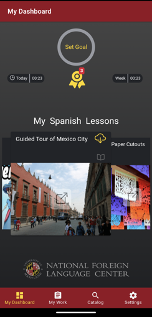
Created at the National Foreign Language Center at the University of Maryland, Lectia provides a way to specifically teach and assess interpretive communication through authentic written and audio resources. Lectia is a collection of lessons each built around a target-language resource found in the real world. Knowing they are being assessed on their understanding of something real gives language learners a sense of practical purpose while completing the lessons. Students are able to choose whatever lessons interest them within their skill level based on a lesson preview that outlines the theme and type of resource the lesson is based on as well as any grammatical/cultural/vocabulary focuses of the text.
Each lesson includes questions based on comprehension of the resource, the meaning of vocabulary words, as well as grammatical and cultural concepts applicable to the text.
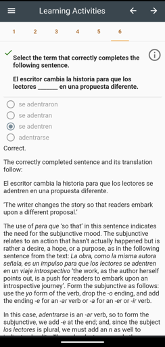
For each lesson, there is a vocabulary glossary that allows you to hear the words spoken by a native speaker, and includes notes, such as if a certain word is primarily used in a specific country. My favorite feature is the spoken transcript of the text that includes highlighted text-tracking, a translation of the text, and audio speed and looping options.
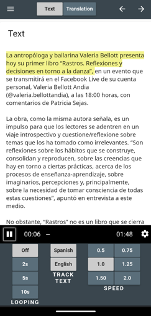
Besides having the ability to choose their own lessons, students work through lessons at their own pace and personal skill level, and also have the ability to set study goals. The app records how much time students have spent studying and how many lessons they have completed.
Setup
Lectia is completely free for all users. The app is available for download in the Apple Download Store or Google Play store. There are no in-app purchases or other hidden costs in the app. There are no ads, so the learning experience is completely uninterrupted and distraction-free. That being said, there are also no subscription options specifically for educators.
Once the app is downloaded, you can choose between 19 language options and three difficulty levels: Beginner, Intermediate, or Advanced. You have the option to set a learning goal for how many hours you would like to study in a week. Users can opt to study multiple languages at varying levels using the same account.
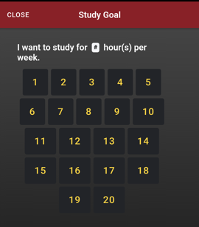
Then you have access to a wide variety of lessons based on authentic resources within the skill level you chose, and can begin studying those that interest you most, at your own pace.
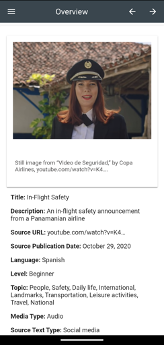
Highlights and Limitations
Lectia excels among other language-learning apps in that it allows students to have agency over the lessons they complete and at what pace they are completed. The outstanding feature of the app is that it teaches exclusively through authentic resources, and provides cultural insights as well as vocabulary and grammar through its wide selection of lessons. It can be a bit cumbersome as you use the arrows to move through the different steps of the lesson; it would be nice to have a tab for each step along the top of the screen to be able to more quickly return to the text/audio as you answer the questions. One limitation is that the lessons in the beginner skill level category seem more advanced than would be possible for a true beginner in a level one class. A significant amount of prior knowledge would still be needed to complete those lessons. Looking at the Spanish lessons in particular in the context of the ACTFL Proficiency Guidelines, I would say most of the lessons start at a Novice High level for listening and a Novice Mid level for reading. In my experience, this has been a Spanish 2 level at my institution.
Uses Inside and Outside the Classroom
Because the app was designed for individual learners, there is no way to compile student data or mass-assign lessons as part of a class. However, the app does have classroom potential.
- It would be possible for an instructor to have all students in the classroom select the same skill level and lesson, so that during/after the lesson there could be discussion about concepts within the resource used.
- Lectia would be a good extension for advanced students to be able to see and apply the concepts taught in class to real life situations once they have finished their classwork for the day.
- It could potentially be used for extra credit or homework points, if students meet a given quota of completed lessons on their own time.
Student Feedback
I implemented Lectia in my Spanish 3 classroom by asking students to complete at least three lessons of their choice during the class period and encouraging them to try different difficulty levels. I also had students complete a survey after completing at least three lessons, in which they ranked the app on the ease of use as well as the engaging nature of the lessons. They also provided their favorite and least favorite aspects of using it. Students enjoyed the authentic lessons, writing comments like, “The lessons aren’t boring but about actual real-life things,” and “I have issues understanding Spanish through audio, so the many lessons based on spoken words are likely to help me.” As far as the ease of use, several students mentioned awkwardness in navigating the app with the arrows provided, and one student commented that, “It just feels like you’re taking a bunch of mini tests.” Students suggested we use Lectia during extra class time, as an entry task, or specifically for its audio-based lessons as listening practice.
Conclusion
Lectia has great potential to provide students with engaging, independent language study in and outside of the classroom. Its incorporation of grammar, vocabulary and cultural information in the lessons provides students with a well-rounded and thorough view of the target language resources used. It illustrates to students how much can be learned from the world around them, that there are lessons to be found everywhere. This is crucial as educators strive to encourage our students to be lifelong learners. Lectia would be a unique and valuable resource in the toolbelt of any language instructor.

